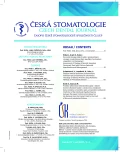Assessment of Therapy of Necrotic Immature Permanent Teeth with Calcium Hydroxide Apexification and Maturogenesis
(Original Article – Clinical Retrospective Cohort Study)
Authors:
R. Žižka 1; P. Krejčí 1; J. Šedý 2,3
Authors‘ workplace:
Klinika zubního lékařství LF UP a FN, Olomouc
1; Ústav normální anatomie LF UP, Olomouc
2; Privátní stomatologická praxe, Praha
3
Published in:
Česká stomatologie / Praktické zubní lékařství, ročník 117, 2017, 3, s. 52-59
Category:
Original articles
Overview
Introduction and aim:
The endodontic treatment of necrotic immature permanent teeth is one of the most demanding intervention in the field of endodontics. In the last two decades there was an emerging evidence supporting the use of regenerative medicine concepts which aims to regenerate pulpdentinal organ. The aim of our study was to compare clinical success rate and change in radiological root area and radiological length between Ca(OH)2 apexification and maturogenesis.
Methods:
Data of patients treated between years 2011 and 2015 at Institute of Dentistry and Oral Sciences in Olomouc who were younger than 16 years and simultaneously underwent endodontic treatment of immature permanent tooth were collected. From total of 54 patients, 17 were chosen according to designated criteria. Nine patients were treated by Ca(OH)2 apexification and 8 by maturogenesis. In the scope of follow-up, the control X-rays were taken and clinical examination was performed. The mathematical correction of control X-rays was carried out and percentual change in radiological root area and radiological length in comparison to diagnostic X-ray were determined. After assessment of normality of collected data with Wilk-Shapiro test, the null hypothesis was examined by student t-test and Wilcoxon signed-rank/rank-sum tests. The clinical outcome was tested by Fisher factorial test.
Results:
There was significant difference in comparison of change in radiological root area among teeth treated with Ca(OH)2 apexification and maturogenesis (p = 0.0041). The average change in radiological root area was 16% in cases treated with maturogenesis and 5.9% in cases treated with Ca(OH)2 apexification. No statistically significant differences were found in radiological length change (p = 0.939) and clinical success rate (p = 0.5459).
Conclusion:
According to our data there were no significant differences between maturogensis and Ca(OH)2 apexification in clinical success rates and change of radiological lengths. Significant difference was observed in the change of radiological root, which was higher in cases treated by maturogenesis.
Keywords:
maturogenesis – revascularization – apexification – immature tooth
Sources
1. Alobaid, A. S., Cortes, L. M., Lo, J., Nguyen, T. T., et al.: Radiographic and clinical outcomes of the treatment of immature permanent teeth by revascularization or apexification: a pilot retrospective cohort study. J. Endod., roč. 40, 2014, č. 8, s. 1063–1070.
2. Bezgin, T., Yilmaz, A. D., Celik, B. N., Kolsuz, M. E., et al.: Efficacy of platelet-rich plasma as a scaffold in regenerative endodontic treatment. J. Endod., roč. 41, 2015, č. 1, s. 36–44.
3. Bose, R., Nummikoski, P., Hargreaves, P.: A retrospective evaluation of radiographic outcomes in immature teeth with necrotic root canal systems treated with regenerative endodontic procedures. J. Endod., roč. 35, 2009, č. 10, s. 1343–1349.
4. American Association of Endodontists: AAE clinical considerations for a regenerative procedure 2015. In., 2015. dostupné na https://www.aae.org/uploadedfiles/publications_and_research/research/currentregenerativeendodonticconsiderations.pdf.
5. Flake, N. M., Gibbs, J. L., Diogenes, A., Hargreaves, K. M., et al.: A standardized novel method to measure radiographic root changes after endodontic therapy in immature teeth. J. Endod., roč. 40, 2014, č. 1, s. 46–50.
6. Jeeruphan, T., Jantarat, J., Yanpiset, K., Suwannapan, L., et al.: Mahidol study 1: comparison of radiographic and survival outcomes of immature teeth treated with either regenerative endodontic or apexification methods: a retrospective study. J. Endod., roč. 38, 2012, č. 10, s. 1330–1336.
7. Kahler, B., Mistry, S., Moule, A., Ringsmuth, A. K., et al.: Revascularization outcomes: a prospective analysis of 16 consecutive cases. J. Endod., roč. 40, 2014, č. 3, s. 333–338.
8. Nagy, M. M., Tawfik, H. E., Hashem, A. A., Abu-Seida, V.: Regenerative potential of immature permanent teeth with necrotic pulps after different regenerative protocols. J. Endod., roč. 40, 2014, č. 2, s. 192–198.
9. Webber, R. L., Ruttiman, U. E., Groenhuis, R. A.: Computer correction of projective distortions in dental radiographs. J. Dent. Res., roč. 63, 1984, č., 8, s. 1032–1036.
10. Žižka, R., Buchta, T., Voborná, I., Harvan, L., et al.: Root maturation in teeth treated by unsuccessful revitalization: 2 case reports. J. Endod., roč. 42, 2016, č. 5, s. 724–729.
Labels
Maxillofacial surgery Orthodontics Dental medicineArticle was published in
Czech Dental Journal

2017 Issue 3
Most read in this issue
-
Burning Mouth Syndrome
(Review) -
Gingivostomatitis Herpetica Acuta in Primary Infection with Human Herpes Virus
(Review) -
Assessment of Therapy of Necrotic Immature Permanent Teeth with Calcium Hydroxide Apexification and Maturogenesis
(Original Article – Clinical Retrospective Cohort Study) -
Prediction of the Interdental Papilla Presence between the Upper Central Incisors Based on the Distance from the Contact Point to the Crest of Bone and Interdental Distance
(Original Article – Clinical Study)
